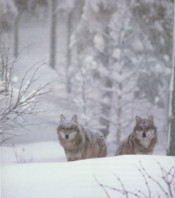 Wolves WolvesWolf History, Conservation, Ecology and Behavior
[www.wolfology.com]
|
Bale Mountain Rodent Communities and Their Relevance to the Ethiopian Wolf (Canis simensis)
Sillero-Zubiri, C.; Tattersall, F.H.; Macdonald, D.W., African Journal of Ecology, 33/4 (December 1995): 301-320
Rodent communities in the Bale Mountains, Ethiopia, form the prey base for the endangered Ethiopian wolf (Canis simensis) and therefore a knowledge of their ecology and biomass is an important management tool. The rodent communities are also of intrinsic interest, being composed of a high proportion of little-known endemic species. Data are presented on the habitat preferences, abundance and biomass of rodents in the Afroalpine belt, the ericaceous belt and montane grasslands of the Bale Mountains. Three species -- Lophuromys flavopunctatus, Stenochepalemys griseicauda and Otomys typus -- characterize the montane grasslands. Stenocephalemys albocaudata, Arvicanthis blicki and Lophuromys melanonyx characterize the Afroalpine belt, and data are presented on their activity and population dynamics. All three species for which data were available bred during the wet season. Minimum density estimates ranged between 32-89/ha for L. melanonyx, 3.2-127/ha for A. blicki and 16-60/ha for S. Albocaudata. The mean monthly biomass of three diurnal rodent species was estimated at 25.7 kg/ha and 23.8 kg/ha in two Afroalpine regions. Ethiopian wolf abundance correlated positively with an index of diurnal rodent biomass and total biomass, but not with nocturnal rodent diomass. Ecological constraints on Afroalpine rodents, their population ecology and their importance in maintaining the Bale Mountains Ethiopian wolf population are discussed.
 A Behavioral Analysis of the Effect of Predator and Prey Densities on Wolf Predation
MacNulty, D., Rocky Mountain Wolf Recovery 2003 Annual Report
The mathematical expression for a predator's "kill rate" (i.e. kills per predator per time) is fundamental to analyses of predator-prey dynamics. Predictions of dynamics vary widely according to how kill rate models assume that kill rate changes with predator and prey densities. Little is known, however, about the behavioral processes generating the relationship between kill rate and predator-prey densities, especially in natural environments. This is an important knowledge gap because it hinders progress in predator-prey theory and confounds predictions of predator-prey dynamics. This study will examine the behavioral mechanisms that cause wolf kill rates to vary with elk, bison and wolf densities in Yellowstone National Park. The analysis will be based on direct observations of wolves and ungulates recorded during eight intensive 30-day study periods from 1995 to 2003. Individual-level analyses of wolf kill rate and its behavioral parameters (i.e. attack rate, handling time, search time) will be completed with general linear and non-linear mixed models to account for correlation among repeated measurements of individual wolves. The results are expected to clarify the basic biology underlying models of wolf kill rate, and thereby strengthen attempts to anticipate the effects of wolf predation on ungulate populations.
 Behavioral Responses of Coyotes to Wolf Recolonization in Northwestern Montana
Arjo, W.; Pletscher, D. Canadian Journal of Zoology, 77 (December 1999): 1919-1927 (9 pp)
Recent recolonization of northwestern Montana by wolves (Canis lupus) provided an opportunity to examine behavioral responses of coyotes (Canis latrans) to a reestablished wolf population. Coyote and wolf annual home ranges overlapped extensively; however, seasonal overlap was not as pronounced. Most seasonal coyote home ranges were located between wolf packs or along the edge of wolf territories, but wolves and coyotes did not use the seasonal overlap area differently than expected. Most of the coyotes maintained random separation distances from wolves, though three coyotes were closer to wolves than expected. No difference in summer activity was found between the canids; however, temporal partitioning occurred during the winter, which may have allowed the increase in home-range overlap observed during the winter. Additionally, temporal partitioning occurred through differential arrangement of canid home ranges (i.e., wolf home ranges were smaller in summer) and reduced overlap of seasonal home ranges. Coyotes were usually singletons and some pairs, and before wolf colonization they fed on lagomorphs and plants. After wolf colonization, coyotes tended to be in pairs and small packs and they relied on ungulates. Although we documented wolves killing coyotes, coyotes are coexisting with wolves through spatial and temporal separation and behavioral changes.
 Beyond Demography and Delisting: Ecological Recovery for Yellowstone's Grizzly Bears and Wolves
Pyare, S.; Berger, J., Biological Conservation, 113/1 (September 2003), 63 (11pp)
This paper addresses the question, when are threatened or endangered species really recovered? The US Endangered Species Act enables the de-listing of species once demographic criteria are met. In the Greater Yellowstone ecosystem, two protected apex carnivores, grizzly bears (Ursus arctos) and wolves (Canis lupus), face removal from federal government protection due to population increases, a point at which they are expected to be integrated components of this ecosystem. We tested the assumption that these two carnivores are playing normative ecological roles in the Yellowstone ecosystem by comparing the extent to which wolves and bears have re-instilled anti-predator responses in a primary prey species, moose (Alces alces), within wolf and bear recovery zones. As a type of control, we contrasted female moose from two areas in Alaska with different predator regimes to those in Wyoming. Populations from mainland Alaska, a region with a relatively intact carnivore assemblage, responded significantly more to odors of both carnivores. In contrast, a basic anti-predator reaction was lacking in Wyoming; and responses to grizzly bear odor only nominally increased after dependent young experienced heightened mortality. Additionally, the level of response among Alaskan moose living under virtual predator-free conditions for 25+ years closely resembled that of conspecifics in Wyoming. That such striking variation in prey responses exists re-enforces critical ecological differences between predator-intact and -defunct systems. Thus, although grizzly bears and wolves in the Yellowstone area will most likely be de-listed within the next few years, whether such action would be ecologically defensible is arguable. At this point in the recovery process, these predators may currently have limited ecological impacts in large portions of this region, at least as gauged by one potentially important prey species, moose....
|
